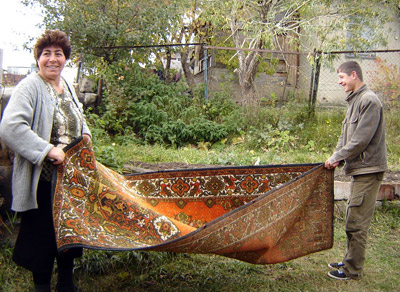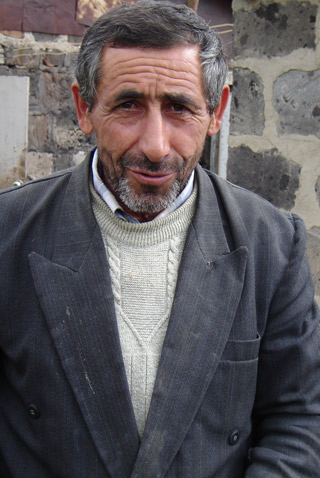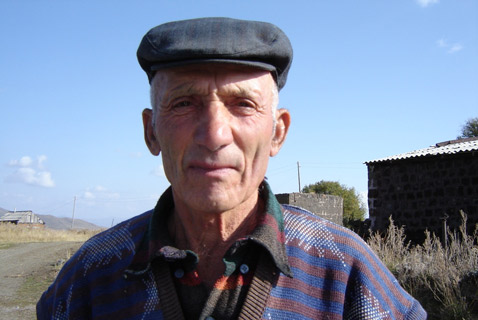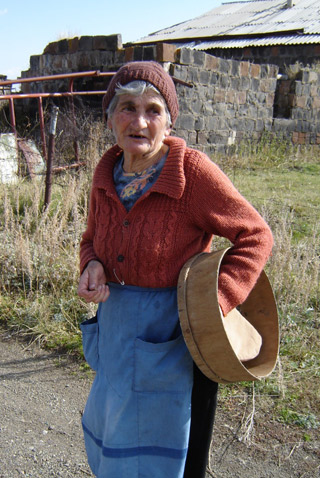
Frontier Villages on Hold: What Do Residents Expect From a Border Opening?
Gtashen: Former Azeri village manages to survive
The village of Gtashen lies a mere two kilometers from the Armenian border with Turkey, in the northern reaches of Shirak Marz. Four border posts are located with its confines. 2,000 hectares of the cultivated lands belonging to Gtashen lie within the border zone, but local residents don’t see this as a major problem.
 “They allow us through with a permit. We do our tilling and sowing, graze the animals without difficulty. I’m amazed to hear that other village mayors along the border are complaining. We have four border posts in the village, and we’ve never had a problem with any of them, “says Mayor Samvel Egnatosyan. This year, the village of Gtashen, formerly in the district of Amasia, will be celebrating the 20th anniversary of its founding. In the past, it was largely inhabited by Azeris. In 1989, the name of the village was changed from Magharajur. The villagers joke that, “We all hail from different places. You can say that by arriving here we have found one another. Thus, the name of the village is quite appropriate; we have found our village (Gtashen, in Armenian, derives from the verb “gtnel” – to find, and “shen”-village) People moved here from Gyumri, Talin, Amasia, Akhalkalak, and as far away as Artsakh to start a new life here on the border. “Village folk are a pretty tolerant lot. There are 95 families living here and in the past twenty years there hasn’t even been 9 ½ arguments that have broken out. That’s a pretty good ratio,” says Mayor Egnatosyan, “I’ve been to some villages where one-half has it in for the other half. Even though they are old villages, they have relatives and friends. We have nothing like that here. Everyone gets along fine with their neighbors. Mayor Egnatosyan only has positive expectations from the government in Yerevan. “Last year they included our village in the “Agricultural Assistance Program”. We received a subsidy and planted barley and wheat. We did pretty well – no complaints,” says the mayor, “This year we were dropped from the program. Turns out that the village is 1870 meters above sea-level and the minimum is 1900. Later, I went and checked the maps and found out that the highest point in the village is actually 1903 meters. It’s just that there isn’t anyone living on the spot.” They’ve advised the mayor to build a small shack on the site and the problem would be solved. “The fact that we live here on the border and defend the line, well, you’d think that nobody actually cared,” complained the mayor, “We do all we can to keep people from leaving, but they turn around and drop us from the program just because of 30 lousy meters.” Anahit Melkonyan and her family, who moved here from Gyumri twenty years ago, have decided to head back. They’ve been promised an apartment in Gyumri next year. Her daughter, a student, and son, who serves in the border patrol, now longer want to stay in the village. Mrs. Melkonyan looks forward to the day that the border is opened. “One can’t go on being enemies forever. Things can possibly work out for the better once the border’s opened. I can’t say for sure.”
“They allow us through with a permit. We do our tilling and sowing, graze the animals without difficulty. I’m amazed to hear that other village mayors along the border are complaining. We have four border posts in the village, and we’ve never had a problem with any of them, “says Mayor Samvel Egnatosyan. This year, the village of Gtashen, formerly in the district of Amasia, will be celebrating the 20th anniversary of its founding. In the past, it was largely inhabited by Azeris. In 1989, the name of the village was changed from Magharajur. The villagers joke that, “We all hail from different places. You can say that by arriving here we have found one another. Thus, the name of the village is quite appropriate; we have found our village (Gtashen, in Armenian, derives from the verb “gtnel” – to find, and “shen”-village) People moved here from Gyumri, Talin, Amasia, Akhalkalak, and as far away as Artsakh to start a new life here on the border. “Village folk are a pretty tolerant lot. There are 95 families living here and in the past twenty years there hasn’t even been 9 ½ arguments that have broken out. That’s a pretty good ratio,” says Mayor Egnatosyan, “I’ve been to some villages where one-half has it in for the other half. Even though they are old villages, they have relatives and friends. We have nothing like that here. Everyone gets along fine with their neighbors. Mayor Egnatosyan only has positive expectations from the government in Yerevan. “Last year they included our village in the “Agricultural Assistance Program”. We received a subsidy and planted barley and wheat. We did pretty well – no complaints,” says the mayor, “This year we were dropped from the program. Turns out that the village is 1870 meters above sea-level and the minimum is 1900. Later, I went and checked the maps and found out that the highest point in the village is actually 1903 meters. It’s just that there isn’t anyone living on the spot.” They’ve advised the mayor to build a small shack on the site and the problem would be solved. “The fact that we live here on the border and defend the line, well, you’d think that nobody actually cared,” complained the mayor, “We do all we can to keep people from leaving, but they turn around and drop us from the program just because of 30 lousy meters.” Anahit Melkonyan and her family, who moved here from Gyumri twenty years ago, have decided to head back. They’ve been promised an apartment in Gyumri next year. Her daughter, a student, and son, who serves in the border patrol, now longer want to stay in the village. Mrs. Melkonyan looks forward to the day that the border is opened. “One can’t go on being enemies forever. Things can possibly work out for the better once the border’s opened. I can’t say for sure.”

Asya Simonyan came to Gtashen from the village of Khorenya near Akhalkalak. “We came and stayed and have no intentions of moving away. “Nothing good will come from opening that border,” says Mrs. Simonyan, "A Turk remains a Turk. We are on the border. We live comfortably enough in between the bad and the good. But when that border opens, things will get pretty tense around here. We are more secure now; with the closed border. When Emma Janountsi, originally from Artsakh, hears the name §Turk¦ or a Turkish word spoken she cringes, as she recollects Images and experiences from her not too distant pass.
 60 year-old Vladimir Hakobyan, Emma’s husband, moved their six member family here from the village of Verin Shen, in the Shahoumyan region of Artsakh. Their seventh child was born in Armenia. They are happy that they now are Gtashen residents and have no intention of returning. They say they are treated well in their new home. “We get along so well here that they all learnt my Armenian and speak to me in the dialect of my village back in Artsakh. I’ve never mastered their dialects. When I try and get things all mixed up – the dialects from Leninakan, Talin and Akhalkalak – that’s how we get along. I only have a bone to pick with the folk from Akhalkalak; they use too many Turkish words when they talk,” says Vladimir Hakobyan. Anna Oumroyan, originally from Talin, hasn’t gotten used to the idea of establishing friendly relations with the neighbor across the border. She says that she’s a granddaughter of a proud family from Sassoun and that hatred of the Turk has been passed down in her genes. “Has our government ever been concerned over the fact that those Turks can flood into our country and one day, who knows, start committing acts of terror?” Anna asks.
60 year-old Vladimir Hakobyan, Emma’s husband, moved their six member family here from the village of Verin Shen, in the Shahoumyan region of Artsakh. Their seventh child was born in Armenia. They are happy that they now are Gtashen residents and have no intention of returning. They say they are treated well in their new home. “We get along so well here that they all learnt my Armenian and speak to me in the dialect of my village back in Artsakh. I’ve never mastered their dialects. When I try and get things all mixed up – the dialects from Leninakan, Talin and Akhalkalak – that’s how we get along. I only have a bone to pick with the folk from Akhalkalak; they use too many Turkish words when they talk,” says Vladimir Hakobyan. Anna Oumroyan, originally from Talin, hasn’t gotten used to the idea of establishing friendly relations with the neighbor across the border. She says that she’s a granddaughter of a proud family from Sassoun and that hatred of the Turk has been passed down in her genes. “Has our government ever been concerned over the fact that those Turks can flood into our country and one day, who knows, start committing acts of terror?” Anna asks.
Kamkhout: 7 families and a few large dogs call this hamlet home some two kilometers north of Gtashen, straddling the Armenian-Turkish border is the tiny village of Kamkhout. The road north, meandering through the valley, takes you to this rural community once called Chakhmakh. Back then, Armenians and Azeris lived here, along with some Greeks, who had their own church in the center of the village. One wall of the ruined church is still in evidence today. There were 60 Azeri and 40 Armenian families living here. During the 1950’s, most of the Armenians moved out, leaving the village in the hands of the Azeris. With the tragic incidents in Sumgait, the future fate of the village was sealed. Chakhmakh, along with other Azeri communities in the Amasia district became ghost towns over night; people just left. To save Chakhmakh from such an inglorious end, some twenty Armenian families from Gyumri decided to move back to the village of their birth. Not all were able to acclimate to their new surroundings. Today, only seven families are left in Kamkhout and only four stay here during the long cold winter months. The village is only a scant thirty meters from the border. It is so tiny, that the hamlet lies within the jurisdiction of Gtashen. Mayor Egnatosyan says he’s been trying to get more families to move to Kamkhout for the past twenty years, but to no avail. Conditions are so poor that those who move here soon leave.
 Grandpa Vachagan is the first to spy a new person or car in the village. “Shouldn’t I be curious, dear girl, to know who has come to our village and why?” argues Vachagan Arakelyan, “We’re in touch with the border patrol. If we spot anything suspicious we immediately give them a call and they do the same for us.” It was grandpa Vachagan’s son, Kamo, who thought of moving her from the village of Voskehask, further down the border. Kamo greets us in the yard outside the family house. Next to him stands a huge village dog. The young man says, with a hint of boasting, “He’s a clever beast. Did you see how he only barked the one time? He realized that you weren’t a threat. But I pity the poor man who winds up in his jaws. I mean those who illegally cross the border,” he jokes and invites us inside. “There are a few dogs like this one in the village. They make things much safer. Even though the guards patrol the border, dogs are the first to know if anything’s amiss.” The grandparents of Kamo’s mother, Mrs. Siranoush, hail from the village of Alvarinj in the Moush region of western Armenia. She speaks in that region’s dialect. Laughing, Kamo says that his mom still hasn’t got used to living so close to the border even though she’s been here for the past twenty years. “My mother is fearful of the Turks. She’ll even lock the front door during the day if she’s home by herself,” he says.
Grandpa Vachagan is the first to spy a new person or car in the village. “Shouldn’t I be curious, dear girl, to know who has come to our village and why?” argues Vachagan Arakelyan, “We’re in touch with the border patrol. If we spot anything suspicious we immediately give them a call and they do the same for us.” It was grandpa Vachagan’s son, Kamo, who thought of moving her from the village of Voskehask, further down the border. Kamo greets us in the yard outside the family house. Next to him stands a huge village dog. The young man says, with a hint of boasting, “He’s a clever beast. Did you see how he only barked the one time? He realized that you weren’t a threat. But I pity the poor man who winds up in his jaws. I mean those who illegally cross the border,” he jokes and invites us inside. “There are a few dogs like this one in the village. They make things much safer. Even though the guards patrol the border, dogs are the first to know if anything’s amiss.” The grandparents of Kamo’s mother, Mrs. Siranoush, hail from the village of Alvarinj in the Moush region of western Armenia. She speaks in that region’s dialect. Laughing, Kamo says that his mom still hasn’t got used to living so close to the border even though she’s been here for the past twenty years. “My mother is fearful of the Turks. She’ll even lock the front door during the day if she’s home by herself,” he says.
 77 year-old Shoushanik Petoyan, who we also met in the village square, was also against the opening of the border. “Our people fled from Ghars. Whenever they show photos of the massacres or speak about those days, a chill runs up my spine. Is it really worth trying to be friends with those blood thirsty people?” she asks. Grandma Shoushanik tells us that a few years ago three men in the village got permission to hunt for badger in the strip of land between the barb wire fences delineating the border. The Turks started to fire upon the men and even rushed down into border corridor, almost reaching the Armenian side. Border guards were able to get the situation under control but the incident only deepened the mistrust of Turks in the village. “They aren’t normal people. They are capable of anything,” says Mrs. Shoushanik. Only rarely is the solitude of life in the border villages of Gtashen and Kamkhout ever violated. The mayor and local residents assured us that the border is well monitored and that they keep an eye out as well. During this entire recent debate about the border opening it would have been nice and, just plain respectful, if some of our political leaders had taken the time to travel to these border outposts and asked the locals what they thought. We’ve all seen the T.V. cameras stop people in the streets of Yerevan, recording their views, but what about those actually living on the front-line? Or is it that their opinions don’t actually matter?
77 year-old Shoushanik Petoyan, who we also met in the village square, was also against the opening of the border. “Our people fled from Ghars. Whenever they show photos of the massacres or speak about those days, a chill runs up my spine. Is it really worth trying to be friends with those blood thirsty people?” she asks. Grandma Shoushanik tells us that a few years ago three men in the village got permission to hunt for badger in the strip of land between the barb wire fences delineating the border. The Turks started to fire upon the men and even rushed down into border corridor, almost reaching the Armenian side. Border guards were able to get the situation under control but the incident only deepened the mistrust of Turks in the village. “They aren’t normal people. They are capable of anything,” says Mrs. Shoushanik. Only rarely is the solitude of life in the border villages of Gtashen and Kamkhout ever violated. The mayor and local residents assured us that the border is well monitored and that they keep an eye out as well. During this entire recent debate about the border opening it would have been nice and, just plain respectful, if some of our political leaders had taken the time to travel to these border outposts and asked the locals what they thought. We’ve all seen the T.V. cameras stop people in the streets of Yerevan, recording their views, but what about those actually living on the front-line? Or is it that their opinions don’t actually matter?
 Videos
Videos Photos
Photos




Write a comment